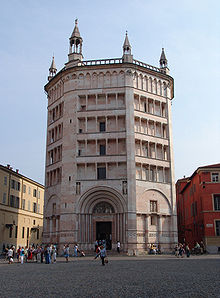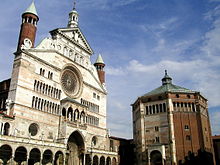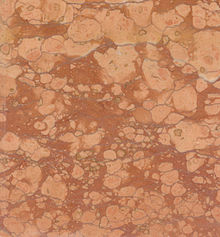Veronese marble



The term Veronese marble ( Italian Marmo rosso di Verona or Marmo di Sant'Ambrogio ) describes numerous color and structural grades of a nodular limestone that is extracted in many quarries in Valpolicella northwest of the city of Verona . This limestone has a tradition of at least two millennia as building and decorative stone in Italy and Europe . Red-brown, red-orange and yellow as well as yellowish-green varieties are known of Verona marble. This results in the Italian name additions Rosso (German: red) and Giallo (German: yellow).
geology
The varieties of Veronese marble come from the regional sediment deposits from the Middle and Upper Jurassic . Essentially, these are the levels Bajocium, Bathonium, Callovium and Oxfordium. The pending layer structure allows these different types of natural stone to be extracted from the respective horizons in the quarries.
All varieties are polishable lump limestone in the petrographic sense, which is called marble in the common parlance of stone processing, its cultural history and trade . The difference to the petrographically defined term marble, in this sense not applicable here, is expressly pointed out here.
The light and dark lime lumps lie in a nuanced matrix. Some benches in the quarries have stylolithic structures that are also reflected in the polished surface.
The hematite content in the limestone banks gives the stone its color in differentiated red tones. Yellow shades are due to a limonite distribution.
The Veronese limes are particularly well known among palaeontologists because of their fossil deposits, especially ammonites . The historical trade name Rosso Ammonitico comes from this optical feature , which was sometimes used for similar decorative rocks in the Alpine region and other regions.
Mining and processing
The main mining area for Veronese marble is the Valpolicella region with the town of Sant'Ambrogio di Valpolicella, which is central for stone mining. Many quarries between Sant'Ambrogio and Monte extract the limestone for further processing. The raw blocks are created using the drilling process or by working with a helicoidal saw .
Raw blocks can be extracted in large or small dimensions depending on the situation of the deposit. Sometimes the dense benches are separated by clay layers. Only flat raw pieces can be dismantled here.
The sawing of panels and their surface processing are largely carried out in companies in the vicinity. In the local businesses of varying sizes there are large-scale technical capacities and studio-like areas for artistic tasks. Ingots are also exported to customers on all continents.
use
The Veronese marble has enjoyed an unusually versatile application for over two thousand years. In Verona, the stone on Roman buildings is contained in the masonry. The greatest example is the Verona Arena . In addition, the stone found widespread use in northern Italy at an early stage. As a result, it has become a striking building and decorative stone in this region. The 14th and early 15th centuries were a particularly intensive period of use for Italian exterior architecture. In contrast to numerous other lumpy limestone, components from certain quarries or individual banks of Veronese marble are remarkably weather-resistant. The typical sign of aging in the outside area is the fading of the red hue, which in the advancing 15th century led to overpainting, gilding and subsequent substitution with other red limestones from Dalmatia on Venetian buildings . In the course of this development, the builders still used the stone for cornices and plinth areas, which, thanks to their red band effect, had an emphasis on the facade design. In contrast, its lively use as flooring material in the interior remained unbroken.
Sarcophagi and epitaphs have been preserved from Veronese marble . The sarcophagus of Francesco Petrarca in Arquà was made from this stone.
In the colorful Baroque era, the Veronese varieties experienced extensive use. The intense red and yellow color of this limestone has challenged previous builders to countless ornamental designs. Numerous splendid floors in northern Italian church buildings are special evidence. They impress with their large-scale geometric and floral patterns and still express the joy of design today. The Verona marble can often be seen in combination with black, white, green and blue-gray natural stone types from Italy and neighboring areas. These fascinating ornamental floors are the subject of several cultural geological researches and publications.
Typical modern products for the types of natural stone from Valpolicella are floor and wall coverings, cladding in bathrooms and other living areas, fireplace facades, door frames, columns, furniture panels, vases, sculptures and design objects.
Application examples
The applications are so varied and extensive that only a few selected representative examples can be given below:
Italy
In the Middle Ages there was a great need for marble in Venice . For this purpose, returning merchant ships were loaded with all kinds of stone. Nevertheless, these deliveries were not enough and building materials were obtained from dilapidated or little-used buildings. In this way in 1458 twelve columns made of white Veronese limestone came from the Church of San Andrea in Ammiana to the Monastery of San Zaccaria .
Venice
The red varieties of Veronese marble enjoyed great demand in Venice in the 14th and early 15th centuries. The Doge's Palace is one of the most exposed examples of this. The use of the stone can be well studied on its facade facing the Piazzetta and Molo.
- San Marco Cathedral , floor elements and floor mosaics
- Church of Santa Maria della Salute (2nd half of the 17th century), floor elements,
- San Salvatore Church (1641), floor elements
Verona
The historic city center of Verona has been a UNESCO World Heritage Site since 2000 and is strongly influenced by the different types of stone.
- Roman arena, masonry
- Church of San Zeno Maggiore , masonry of the facade, columns of the cloister, interior, crypt
- Sarcophagus of Cansignorio
- Facade of the town hall
- Courtyard of the Mercato Vecchio
- Church of Sant'Anastasia, ornamental floor ( Biancone , Rosso Verona and others), columns, sculptures
- Ponte di Pietra bridge (Latin: Pons marmoreus )
- many town houses in the historic city center, portals, architectural parts
Other cities
- Bergamo: Cappella Colleoni , facade elements
- Seriate (near Bergamo): New building of the church by Mario Botta (2008)
- Bologna: Basilica of San Petronio , facade elements
- Cremona: cathedral and baptistery, facade parts
- Parma: Baptistery of the Duomo in Piazza Battistero, facade
Germany
Berlin
- Museum for Communication Berlin (staircase, balustrades: Rosso, steps and platforms: Nembro Giallo)
- Berlin Cathedral , column bases (Nembro Giallo)
- St. Hedwig's Cathedral , older burial chapel in the lower church
Austria
Vienna
- Palais Gustav von Epstein , large fluting | fluted columns and pilasters on the main staircase
- Haas-Haus , interior design on the floors
- Graben-Hof, monolithic columns on the facade
- Max Weiß von Wellenstein house, pillars in the stairwell
- Amerika-Haus (Friedrich Schmidt-Platz 2), pillars on the facade
- Atonement house, floor slabs
Varieties and Competing Materials
The variety denominations show some differences and peculiarities between domestic (Italian) and foreign usage habits. Internationally, the group names Rosso Verona for the reddish and Giallo Verona for the yellowish varieties are common. In the Italian natural stone industry, other names are used in addition to these main names. These additional variety names are used to differentiate available color and structure nuances and to enable the processing natural stone companies as well as their customers to provide professional advice. In this regard, one uses, for example, Rosso sanguigno , Rosso brocato , Verdello , Nembro rosato or Gialetto . These names are assigned to specific color and structure images that can be clearly distinguished from one another. In terms of character, these common names embody a centuries-old wealth of experience of the stone processors from the versatile technical and artistic handling of their material. Today they can be understood as part of the cultural heritage of an important pan-European natural stone region that has given significant impulses for art, aesthetics and building culture far beyond its borders.
A clear delimitation of the commercial varieties according to stratigraphic points of view is difficult. Mainly the yellow to red varieties of the Lower Rosso Ammonitico (meaning layers of the middle Jura ) from the varieties of the Upper Rosso Ammonitico (upper Jura and in the transition to the lower Cretaceous ) are strong red tones with the final stage of Biancone (very light limestone) distinguish. The Rosso magnaboschi is also obtained in the upper Jura layers, and is said to have good frost resistance.
The respective variety names have undergone constant change over the centuries and have left us with a rich cultural richness. A complete list would go beyond the scope of an encyclopedia. Some examples should be mentioned: Brocatello rosso vivo , Nembro giallognolo , Palombino bianco , Cengia Mandorlata or Mandorlato di Verona . The name Mandorlata alludes to the apparent appearance, which is reminiscent of almonds due to the tuberous structures in the section against the bed (against the stratification level).
Competing stones
In addition to Valpolicella, the regions around Asiago and Trento as well as Sicily are the sources for similar varieties. Furthermore, individual stones from the Salzburg area ( Adneter marble ), France, Hungary and Greece have comparable colors and structures.
In the German-speaking countries, the varieties Rosso Verona and Rosso Asiago are mainly used, but they are completely undifferentiated and subsume several red varieties from the respective mining area.
literature
- Nicholas Penny: History of Sculpture . EA Seemann, Leipzig 1995, ISBN 3-363-00646-2 .
- Raymond Perrier: Les roches ornementales . Ternay 2004, ISBN 2-9508992-6-9 .
- Monica T. Price: Decorative stone, the complete sourcebook . Thames & Hudson, London 2007, ISBN 978-0-500-51341-5 .
- Fabrizio Rossini (ed.): The marble in Verona . asmave, Verona 1987.
- Tudy Sammartini, Gabriele Crozzoli: Stone floors in Venice . Hirmer, Munich 2000, ISBN 3-7774-8570-5 .
- Wolfgang Wolters: Architecture and Ornament. Venetian architectural jewelry of the Renaissance . CH Beck, Munich 2000, ISBN 3-406-45906-4 .
- Ludwig Friedrich Wolfram: Complete textbook of the entire architecture. First volume: Doctrine of natural building materials, first section. From natural building materials . Carl Hoffmann, Stuttgart / Carl Gerold'sche Buchhandlung, Vienna 1833.






